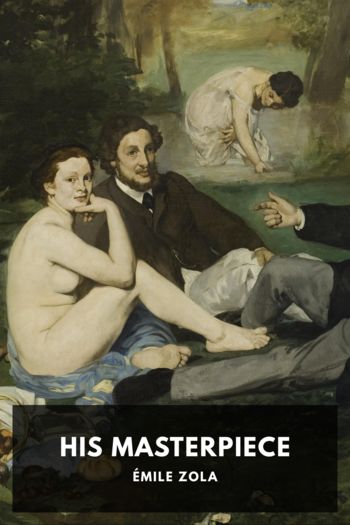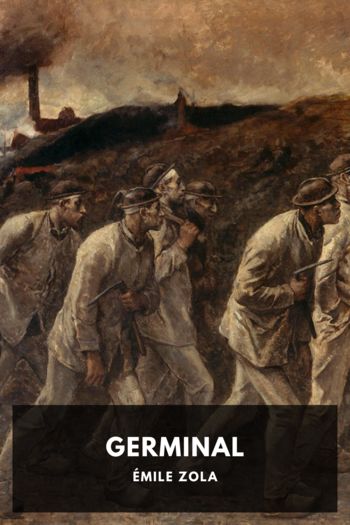His Masterpiece, Émile Zola [essential reading txt] 📗

- Author: Émile Zola
Book online «His Masterpiece, Émile Zola [essential reading txt] 📗». Author Émile Zola
“Ah! his old canvases,” resumed Bongrand, “the things he had at the Quai de Bourbon, do you remember them? There were some extraordinary bits among them. The landscapes he brought back from the south and the academy studies he painted at Boutin’s—a girl’s legs and a woman’s trunk, for instance. Oh, that trunk! Old Malgras must have it. A magisterial study it was, which not one of our ‘young masters’ could paint. Yes, yes, the fellow was no fool—simply a great painter.”
“When I think,” said Sandoz, “that those little humbugs of the School and the press accused him of idleness and ignorance, repeating one after the other that he had always refused to learn his art. Idle! good heavens! why, I have seen him faint with fatigue after sittings ten hours long; he gave his whole life to his work, and killed himself in his passion for toil! And they call him ignorant—how idiotic! They will never understand that the individual gift which a man brings in his nature is superior to all acquired knowledge. Delacroix also was ignorant of his profession in their eyes, simply because he could not confine himself to hard and fast rules! Ah! the ninnies, the slavish pupils who are incapable of painting anything incorrectly!”
He took a few steps in silence, and then he added:
“A heroic worker, too—a passionate observer whose brain was crammed with science—the temperament of a great artist endowed with admirable gifts. And to think that he leaves nothing, nothing!”
“Absolutely nothing, not a canvas,” declared Bongrand. “I know nothing of his but rough drafts, sketches, notes carelessly jotted down, as it were, all that artistic paraphernalia which can’t be submitted to the public. Yes, indeed, it is really a dead man, dead completely, who is about to be lowered into the grave.”
However, the painter and the novelist now had to hasten their steps, for they had got far behind the others while talking; and the hearse, after rolling past taverns and shops full of tombstones and crosses, was turning to the right into the short avenue leading to the cemetery. They overtook it, and passed through the gateway with the little procession. The priest in his surplice and the choirboy carrying the holy water receiver, who had both alighted from the mourning coach, walked on ahead.
It was a large flat cemetery, still in its youth, laid out by rule and line in the suburban waste land, and divided into squares by broad symmetrical paths. A few raised tombs bordered the principal avenues, but most of the graves, already very numerous, were on a level with the soil. They were hastily arranged temporary sepulchres, for five-year grants were the only ones to be obtained, and families hesitated to go to any serious expense. Thus, the stones sinking into the ground for lack of foundations, the scrubby evergreens which had not yet had time to grow, all the provisional slop kind of mourning that one saw there, imparted to that vast field of repose a look of poverty and cold, clean, dismal bareness like that of a barracks or a hospital. There was not a corner to be found recalling the graveyard nooks sung of in the ballads of the romantic period, not one leafy turn quivering with mystery, not a single large tomb speaking of pride and eternity. You were in the new style of Paris cemetery, where everything is set out straight and duly numbered—the cemetery of democratic times, where the dead seem to slumber at the bottom of an office drawer, after filing past one by one, as people do at a fête under the eyes of the police, so as to avoid obstruction.
“Dash it!” muttered Bongrand, “it isn’t lively here.”
“Why not?” asked Sandoz. “It’s commodious; there is plenty of air. And even although there is no sun, see what a pretty colour it all has.”
In fact, under the grey sky of that November morning, in the penetrating quiver of the wind, the low tombs, laden with garlands and crowns of beads, assumed soft tints of charming delicacy. There were some quite white, and others all black, according to the colour of the beads. But the contrast lost much of its force amid the pale green foliage of the dwarfish trees. Poor families exhausted their affection for the dear departed in decking those five-year grants; there were piles of crowns and blooming flowers—freshly brought there on the recent Day of the Dead. Only the cut flowers had as yet faded, between their paper collars. Some crowns of yellow immortelles shone out like freshly chiselled gold. But the beads predominated to such a degree that at the first glance there seemed to be nothing else; they gushed forth everywhere, hiding the inscriptions and covering the stones and railings. There were beads forming hearts, beads in festoons and medallions, beads framing either ornamental designs or objects under glass, such as velvet pansies, wax hands entwined, satin bows, or, at times, even photographs of women—yellow, faded, cheap photographs, showing poor, ugly, touching faces that smiled awkwardly.
As the hearse proceeded along the Avenue du Rond Point, Sandoz, whose last remark—since it was of an artistic nature—had brought him back to Claude, resumed the conversation, saying:
“This is a cemetery which he would have understood, he who was so mad on modern things. No doubt he suffered physically, wasted away by the over-severe lesion that is so often





Comments (0)